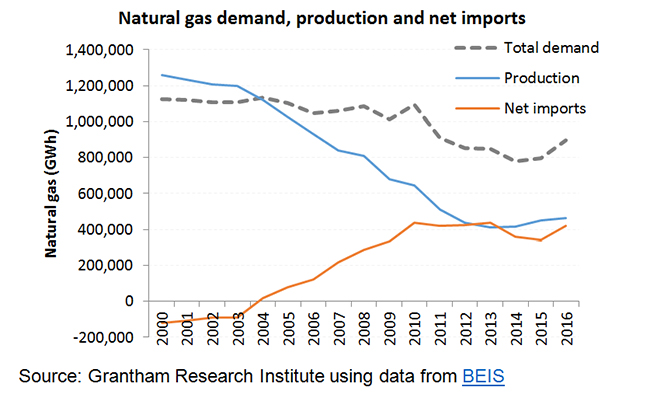What is gas’s role in the energy mix in the UK and what is the Government’s strategy on gas?
1. What role does gas play in the UK’s energy mix?
Natural gas currently plays a significant role in the UK’s energy mix, with a notable increase in the proportion of electricity generated in Q2 2017 from gas at 41.3 per cent, up by 13 percentage points from 2015. This is due largely to gas replacing coal. Furthermore, nearly 85 per cent of the UK’s 26 million homes are heated by gas.
Up until 2004, the UK could almost entirely rely on its own supply of natural gas, extracted from the seabed on the UK continental shelf. Domestic supplies started to decline from 2000, and in 2013 they reached their lowest level at 410,000 gigawatt hours (GWh), about a third of what they were a decade earlier.
However, recently there has been a slight upturn, with production reaching about 460,000 GWh in 2016. Production rose by a further 6.5 per cent in the first half of 2017, following the start-up of the Laggan field (to the west of Shetland) and the Cygnus field (in the North Sea).
The UK is a net importer of gas: that is, it imports more than it exports. Net imports in 2016 accounted for 47 per cent of domestic demand. More than half the imported gas is transported by pipelines from Norway, Belgium and the Netherlands, while the rest is shipped as liquid natural gas, mostly from Qatar.

2. What is the UK’s gas generation strategy and how does it fit with decarbonisation targets?
The Gas Generation Strategy was published under the Conservative and Liberal Democrat coalition government in December 2012. Emphasising the Government’s view that gas will continue to play a major role in the UK’s electricity mix over the coming decades, its stated objective was to reduce the uncertainty around gas generation for investors.
There are some inconsistencies between the Gas Generation Strategy and the UK’s wider decarbonisation ambitions and targets. The strategy suggests that the UK’s carbon budgets could be relaxed in order to allow more natural gas to be burnt for electricity. This could undermine efforts to reduce emissions cost-effectively and make the carbon intensity of the power sector much higher than the level recommended by the Committee on Climate Change in the fourth carbon budget (applicable at the time at which the strategy was published).
There is also a risk that the implementation of the high carbon intensity scenario in the strategy could undermine efforts to decarbonise the UK’s power sector. Analysis by the Grantham Research Institute suggests natural gas may play a role in the transition to a low-carbon electricity system, but that role can only be significant beyond the 2020s if carbon capture and storage technology is deployed on a commercial scale.

